 |

5. A typical day on board? What are the kids' responsibilities aboard?
A “typical” day at anchor 
Early morning wake-up, Bernie and the kids. Coffee for Michelle, sometimes even in bed.
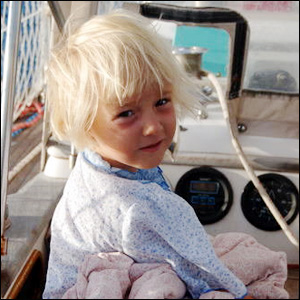 |
| Early morning in the cockpit |
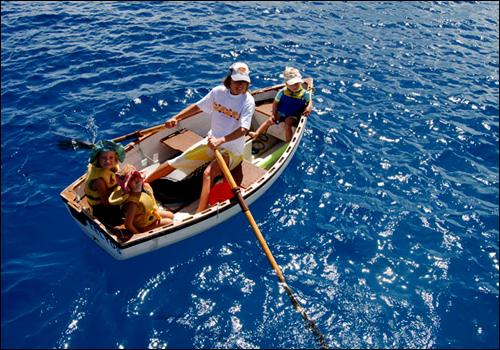 |
| Off to visit friends on Eelyos |
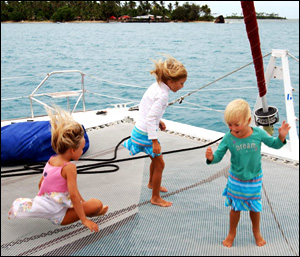 |
| Other boats are fun, too! |
Reading, writing, exchanging news stories (if we are online) and projects. Kids play inside in their rooms, draw at the table (with both parents with both laptops), write and read, go outside to swing and play up on the foredeck. Swinging on halyards, building tents on the foredeck. Kids in and out – snacks, drinks, calling a friend on the radio if there are any close by. Usually on board all morning – it takes us a while to get going.
- If there is a morning market, Michelle will go ashore early, sometimes with kids sometimes without, depending on their moods and other activity.
-
If it's an anchorage with spearfishing, Bernie or Michelle will go searching for dinner.
If it's a sharky area, we go as a family, with one adult in the water with the speargun and the other trailing close behind in the dinghy, Lola and Jana offering commentary all along the way. This is one of our favorite things to do – either snorkeling or fishing, trailing the dinghy behind.
Kids will play in the water on boogie boards or swim with fins and snorkels, and we'll explore all together.
One adult might go off alone fishing; one adult always stays with the kids.
- If we catch a fish in the morning, we eat it for lunch, and that is our main meal of the day. If it is a large one, we may smoke it – either on shore or on our handy back-rail smoker that Bernie designed.
We discovered the joys of smoked fish and the fun of spearfishing in the Sea of Cortez with our friend Bill on MoonHunter, and we've been loving that part of our onboard life ever since.
After lunch, an afternoon of swimming, snorkeling, playing at the beach (if we've not been swimming and fishing all morning), exploring on shore, or visiting friends if they are in the anchorage.
Collecting local fruit, visiting people, walking, spearfishing if we didn't do it in the morning.
Evenings are back at home, almost always.
With small kids we don't go out a lot, but hanging out with friends is something we do quite often, if we are sharing anchorages. Either on their boat or ours. Kids love to explore other boats, so any excuse to go to another is always greeted with shouts of joy.
Cooking is a big deal – we share recipes with friends, try out new things, experiment.
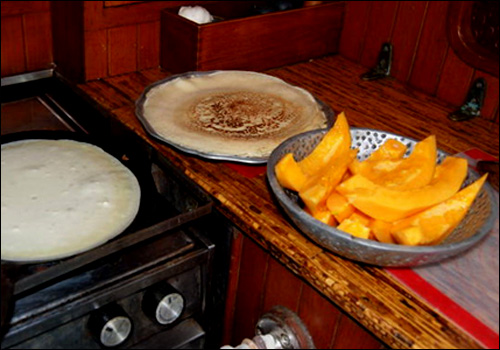 |
| Papaya goes with everything! |
I put papaya in just about anything, sweet or savory. Pizza, pasta, curry, fishcakes, bread… you name it.
Even in hot climates, we bake year round. With two young daughters, I bake a lot of bread, cookies, etc. Christmas, even in the southern hemisphere, always includes my mother's long list of baked goods.
We put a fan in the kitchen window, blowing all that oven air OUT. It is hot but delicious.
Baking is a regular part of life -- at anchor we have time, and time is what you need for a good recipe. |
A “typical” day on passage
Much of the same, without exiting the boat!
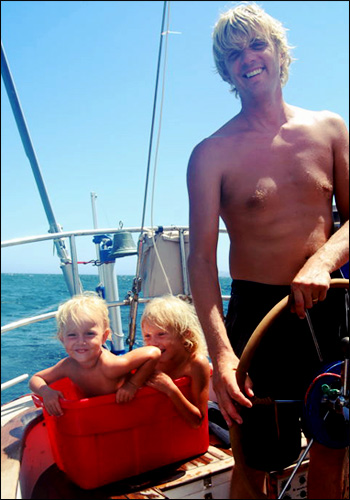 |
| Underway on a calm day -- bathtime! |
We do not keep a ‘watch schedule’ as such.
One adult sleeps when tired, and the other keeps watch. The way it works for us is that usually one adult goes to bed with the kids, around 9pm and sleeps as long as the watcher can stay awake.
Our nights are usually broken up into two shifts: one person on watch from 9 til 2 or 3, the other on watch from 2/3 til 8-9. Kids sleep all through the night, so they get up going strong by 7 no matter what.
What's nice about this night schedule is that it gets us all together in the morning, at least for a couple hours, until one of us needs a nap (and it provides each adult one long segment of sleep, and one long segment of quiet writing time -- something we both enjoy.)
So our day begins thus, with coffee/tea/cocoa for everyone. Cheerios or porridge for the kids.
Most days go by seamlessly.
It's hard to say what we really do. We are a fairly self-contained group, so we have no trouble entertaining ourselves. Our lives have never included television or video games, so we do not find ourselves missing those things.
- We watch a lot of movies, however. We love movies and entertainment, but we hate advertising. So we have a large collection of movies on our hard drive, collected along the way, and we don't have to watch ads for Dodge Rams or Baby Einstein or any other must-haves.
Some of our movies in the collections we get from friends are not fit for children, some are not fit for anyone. We laugh when we come across a title we've never heard of and accidentally stumble into porn at 10am. We find age-appropriate films for our children. As a family, we watched the entire Lord of the Rings trilogy on our first big ocean crossing, from Mexico to Hawaii back in 2004. We have tried to make our kids watch The Office, but they outright reject it. We watch The Wire when the kids are sound asleep.
- We read, we write, we play games. The kids make up games, they draw, they color, they make poorly designed origami animals, they rig up swings, they argue, they get separated and sent to their rooms (unless it's rough, in which case Lola does not go to the forepeak, because even when she's naughty that is a punishment no one should have to endure). We cook, bake and eat. We never drink alcohol while underway. Ever.
-
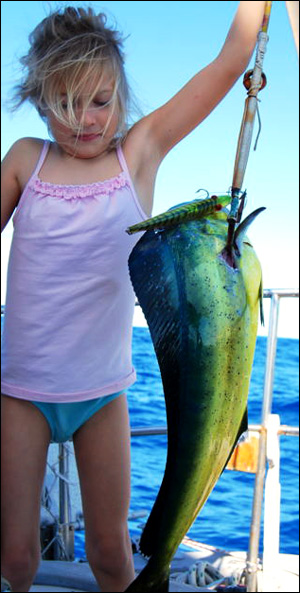 |
| Mahi-mahi for dinner! |
We throw a line off the stern and see who comes for dinner. Mahi-mahis are very popular in our family.
We celebrate every single time we bring dinner aboard -- it is a huge family affair. Line whirs out, someone yells “Fish on!” and we all rush to see. Someone brings the line in -- usually Bernie or Michelle but sometimes Lola too, if it's not too big. Jana grabs the camera and brings it out. We bring the catch on board as efficiently as we can, bleed it in the bottom of the cockpit, and set to cleaning it. Usually a few thoughts are exchanged about ecology and balance of nature, about man and his carnivorous nature and where we all fit into the food chain.
Sometimes it's a biology lesson, with the kids asking lots of questions, investigating the stomach contents, poking into the eyes and brain (see video here).
Then, when the fish is cleaned and bagged for storage, we feast. No matter what time of day: we eat the fish fresh -- breakfast, lunch and dinner. We eat fish for days and days, and when the supply is running low, we throw the line out again. We do not have a huge freezer, so we cannot store too much – we catch it as we can eat it.
And though our kids are relatively picky eaters, we all agree that there's not much better than fresh fish, so it is a celebration every single time.
- Every few days, we go out into the cockpit (weather permitting) and have a salt-water bath. The sea water is invigorating and clean. We rinse our hair down with a cup of fresh.
- We send emails every few days but do not generally keep a schedule, because we do not like for our families to set up expectations which, if unmet, would cause alarm. They know that no news is good news, and we send email updates every few days via winlink.
In short, our lives are much like they are when we are anchored, except that we pack a year's worth of movie pleasure into a short timespan, we fish off the back of the boat, and we never ever leave the safety of Momo.
(Some people get a kick out of swimming offshore, but this is a point we both agree on: we are just too chicken and do not feel the need to swim with whatever's lurking under our keel in mid-ocean.)
 |
Kids can relax
almost anywhere... |
If it is calm, we tend to boat chores during the day. During two weeks lingering at the equator a couple years back, Bernie spent days replacing bungs on our deck. We've tended to the rig, repaired the toilet, mended sails.
We take pictures of wondrous blue.
If it is rough, we hunker down in the couch with the leecloth or in the aft cabin and read if possible, or watch movies, or sleep. We huddle and cuddle. (It seems to be comfortable there -- the girls love it, spend hours in there sleeping or with their portable DVD player on rough days.)
More than anything else, a passage is for us not an event to be endured but something to be experienced, one moment at a time. No one loves the rough days, but they go with the territory, and being at sea is something quite special.
Writing about what we actually ‘do' sounds quite boring, but it's not the doing but more the state of mind.
And I don't mean it in the typical “the meaning is in the journey” sort of philosophical musing, but in that being at sea is just one way we happen to spend our lives, so we do at sea what we generally do when not at sea.
It helps that no one in our family is prone to mal de mer. Bernie is the only one who might require a patch behind the ear every now and again, and that seems to set things straight.
We depart an anchorage not with the destination in the front of our minds but in the back of our minds. We'll get there soon enough, but we are never in any rush.
We depart an anchorage thinking “we are going to sea!” and we usually smile all the way there.
BERNIE:
Naturally, it's a good idea to be well-prepared for any passage. But for the most part, passage-making is profoundly uneventful.
Our approach to passage-making is to think about the voyage as something that happens when we're doing other things. Those things vary, of course, from watching movies, to reading books, baking cakes, “improving” the boat, etc.
The voyage recedes into the background, and we get on with our everyday lives. Eventually we get where we're going, but since the trip itself and counting miles isn't a major focus, we rarely feel an urgency to get off the boat. |
Kids, what are your responsibilities aboard?
LOLA (8):
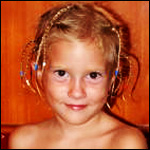 |
|
- We keep things tidy (we try to, sometimes we don't succeed).
- I check for traffic when we are sailing.
- I watch everything -- pulling up the anchor, setting anchor, all the work on the boat.
- At anchor, I watch Dad work on the boat, like building the dodger, working with fiberglass -- sometimes I help.
- We help Mom with cooking and baking.
- When Mom and Dad are working together, we look out for each other.
- When they go out to reef or change sails or do something else, we stay in the couch or go into our parents' bed and take care of each other.
- Occasionally, Jana and I like to clean up as a surprise for Mom when she is off the boat for a few hours.
|
JANA (6)
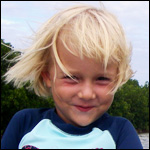 |
|
My jobs:
- When we are sailing, I steer the boat, I check for traffic, I throw the trash overboard (Mom's note: perishable rubbish, not plastic).
- When we are at anchor, we go to shore to help with groceries. I always help with hanging up laundry!
|
We know the rules.
- We don't go outside without a parent when we are offshore.
- We don't climb the lifelines (when we are underway).
|
|
|
|